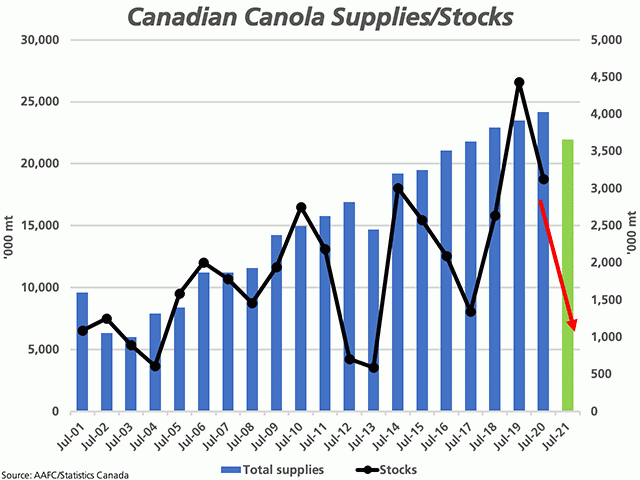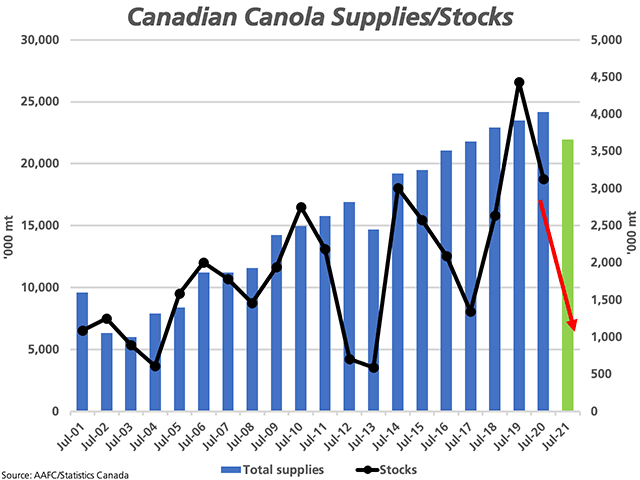Canada Markets
Statistics Canada Updates Crop Production Estimates
The long wait for updated forecasts following the early harvest is over with the release of Statistics Canada's November estimates. While the first two production estimates were based on model results, the final estimates were based on November surveys of 26,800 producers, including the smaller-producing provinces where production is estimated in the earlier reports.
Canada's all-wheat production was estimated at 35.183 million metric tons, 1 mmt higher than estimated in September, while close to the upper-end of the range of pre-report estimates. If achieved, this crop is up 7.7% from 2019 and is 13.4% higher than the five-year average, while the second largest on record next to the 37.6 mmt produced in 2013.
Spring wheat production was estimated at 25.841 mmt, down 0.4% from 2019 and 14.1% higher than the five-year average. Harvested acres were down 2.8% across the country at 17.7 million acres, with an increase in harvested acres in Manitoba offset by a drop in both Saskatchewan and Alberta.
The average spring wheat yield across the country is reported at a record 53.6 bushels per acre (bpa), with a record set in Manitoba of 61.5 bpa, a record set in Saskatchewan at 48.7 bpa, while the Alberta average at 56.8 bpa is up from last year but 2 bpa below the record set in 2016.
Hard red spring wheat production, as a percentage of total spring wheat production, fell to 21.933 mmt or 84.9% of the total spring wheat production, down from 86.4% in 2019 and above the five-year average of 84.5%.
Winter wheat production was reported at 2.770 mmt, the highest in three years and 6.2% above the five-year average.
Canada's durum production was estimated at 6.571 mmt, closer to the upper-end of the range of pre-report estimates. This is 31% higher than 2019 production and 13.6% higher than the five-year average.
Today's report increased Canada's estimated wheat supplies (excluding durum) by 600,000 mt, while year-to-date exports through the end of week 16 are 1.5 mmt higher than the same period last crop year. The potential still exists for stocks to fall year-over year, depending on exports over the balance of the year.
Canada's estimated durum supplies increased by an amount of 437,000 mt, while exports also remain on a fast pace. This report could be viewed as moderately bearish, depending on the pace of exports over the balance of the crop year.
Today's surprise is focused largely on Statistics Canada's canola production estimate. At 18.720 mmt, the estimate was slightly below the lower-end of the range of pre-report estimates, down 4.5% from 2019, down 6.2% from the five-year average and the lowest in five years.
P[L1] D[0x0] M[300x250] OOP[F] ADUNIT[] T[]
Harvested acres of canola fell year-over-year in both Saskatchewan and Alberta, offsetting a gain in Manitoba, with the country's acres down 1.6% overall to 20.6 million acres. The national average yield fell by 3.1% from 2019 to 40.1 bpa, with drops reported across all three prairie provinces. As we've followed over the past months, the estimate for Saskatchewan at 39.8 bpa is still 2.8 bpa higher than estimate from the provincial government's estimates.
Today's report may come as a surprise due to this week's ICE Canada canola commentary that suggested the trade was spit on whether we'd see a small upward revision or a small downward revision in today's numbers. If we go back in time, Statistics Canada's estimate based on the July model data was 19.403 mmt, while was revised only slightly lower to 19.393 mmt, which seemed to totally overlook the weeks of hot weather in August that took is toll on crops in the western prairies and ending flowering prematurely.
The attached chart shows crop year supplies set to fall for the first time in eight years (green bar, primary vertical axis) to 21.951 mmt based on Statistics Canada's July 31 stocks estimate and today's production estimate.
When one considers that licensed exports through the first 16 weeks of the crop year are 1.1 mmt ahead of the pace realized in 2019-20 while domestic disappearance is closely tracking last year's pace with the most recent October crush at a record level, 2020-21 crop year stocks are on track to fall sharply (black line, red arrow against the secondary vertical axis) to levels well-below 1 mmt and will require rationing of demand this crop year.
Canada's barley production was revised higher to 10.741, slightly above the range of pre-report estimates reported by media. This is up 3.4% from 2019, 22.7% higher than the five-year average and would be the largest production seen since 2008. While this estimate adds close to 500,000 mt to the balance sheet from the previous estimate, the pace of barley exports, the cash flow from higher crop prices such as pulses and canola, the high numbers of cattle on feed and the uncertainty in the corn market should keep barley prices firm while current estimates would indicated stocks will grow for a second year.
Oat production was revised slightly higher from the September estimate to 4.576 mmt, up 8.3% from 2019 and 26.7% higher than the five-year average. This is the largest crop since 2007, while current estimates suggest that stocks will grow for a second year.
Statistics Canada estimated lentil production at 2.868 mmt, down from the 3.065 mmt estimated in September. This volume is within the range of pre-report estimates, while is 20.4% higher than realized in 2019 and 11.4% higher than the five-year average. This is bullish for lentils with stocks expected to fall to pipeline levels in 2020-21 prior to the release of this report.
At the same time, today's data shows an upward revision in dry pea production to 4.594 mmt, up 8.4% from 2019 and 15% higher than the five-year average. Stocks are already estimated to end 2020-21 at a tight level, while increased production could possibly be offset with higher exports.
Canada's soybean crop production estimate was revised slightly higher in December to 6.359 mmt, a volume that is up 3.5% from 2019 and down 7.4% from the five-year average. Harvested acres fell by 10% across the country in 2020 to 5.044 million acres, with a year-over-year reduction across all major growing areas. The largest percentage drop was seen in Manitoba at 19%, while the year-over-year acreage drop in Manitoba of 266,500 acres was only slightly higher than the 256,300 acre drop in Ontario.
The average national yield increased by 15% year-over-year to 46.3 bpa, a record national yield, with an increase seen in major producing provinces of Manitoba, Ontario and Quebec.
Despite the upward revision, estimated supplies of 7.080 mmt would be the lowest in six years, while given strong Asian demand and the current pace of exports, stocks should fall to tighter levels in 2020-21.
The size of Canada's corn crop was scaled back this month from the September estimate. Production is estimated at 13.563 mmt, up 1.2% from 2019 and 1.6% below the five-year average. Production is estimated to fall in Quebec and Manitoba while rising in Ontario, with an increasing yield estimate in all major production provinces offsetting declining harvested acres in the same provinces.
Statistics Canada estimated Ontario corn yield at 163.9 bpa, while two private crop tours this fall arrived at an average yield of 183.3 bpa and 186.0 bpa. This bears watching, with Ontario harvesting 61.5% of Statistics Canada's estimated harvested acre, indicating that current estimates may be understated.
**
DTN virtual Ag Summit
DTN's virtual Ag Summit will be held on Dec. 7-9. The following link provides an excellent account of the proceedings over these days and information on how to register.
**
DTN 360 Poll
This week's poll asks what you think of the interim trade deal announced between Canada and the United Kingdom. You can weigh in with your thoughts on this poll, located at the lower-right side of your DTN Canada Home Page.
Cliff Jamieson can be reached at cliff.jamieson@dtn.com
Follow him on Twitter @Cliff Jamieson
(c) Copyright 2020 DTN, LLC. All rights reserved.





Comments
To comment, please Log In or Join our Community .